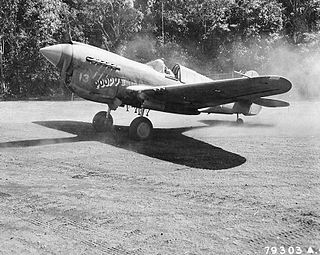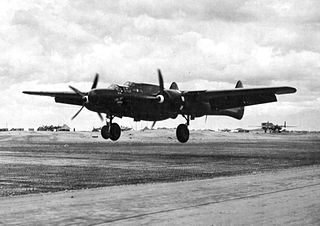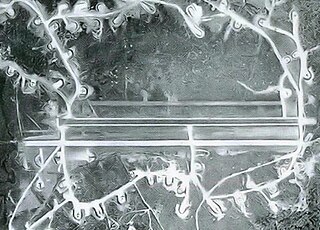
Royal Air Force Boxted or more simply RAF Boxted is a former Royal Air Force station located 4 miles (6.4 km) north-northeast of Colchester, Essex England.
Buka Airport is an airport serving Buka Island in the Autonomous Region of Bougainville in Papua New Guinea.

Girua Airport is an airport serving Popondetta, a city in the Oro province in Papua New Guinea.

The Battle of Kaiapit was an action fought in 1943 between Australian and Japanese forces in New Guinea during the Markham and Ramu Valley – Finisterre Range campaign of World War II. Following the landings at Nadzab and at Lae, the Allies attempted to exploit their success with an advance into the upper Markham Valley, starting with Kaiapit. The Japanese intended to use Kaiapit to threaten the Allied position at Nadzab, and to create a diversion to allow the Japanese garrison at Lae time to escape.

The 108th Operations Group is a unit of the 108th Wing of the New Jersey Air National Guard, one of the many units stationed at the McGuire AFB entity of Joint Base McGuire-Dix-Lakehurst, New Jersey. If activated to federal service with the U.S. Air Force, the group is gained by Air Mobility Command.

The 309th Air Division is an inactive United States Air Force organization. Its last assignment was with Continental Air Command, assigned to Twelfth Air Force at Hensley Field, Texas. It was inactivated on 27 June 1949.

The 308th Bombardment Wing is an inactive United States Air Force unit. Its last assignment was with Far East Air Forces at Nagoya, Japan, where it was inactivated on 30 June 1948.

The 41st Flying Training Squadron is part of the 14th Flying Training Wing based at Columbus Air Force Base, Mississippi. It operates Beechcraft T-6 Texan II aircraft conducting flight training.

During World War II, the United States Army Air Forces established a series of airfields in Australia for the collective defense of the country, as well as for conducting offensive operations against the Imperial Japanese Army and Navy. From these airports and airfields in Australia, the Fifth Air Force was able to regroup, re-equip and begin offensive operations against the Empire of Japan after the disasters in the Philippines and Dutch East Indies during 1942.

The 403d Bombardment Squadron is an inactive United States Air Force unit. It was last assigned to the 43rd Bombardment Wing at Carswell Air Force Base, Texas, where it was inactivated on 1 January 1961.
Saidor Airport is an airport in Madang Province, Papua New Guinea.. It is a general aviation airport located at the coast near Saidor, near Saul Point with Dekys Bay to the east and the Bismarck Sea to the north.
Finschhafen Airport is a general aviation airport in Morobe Province, Papua New Guinea.. It is located on the south-east tip of Huon Peninsula at Finschafen. A half mile inland, parallel to Schneider Harbor, with Dregerhaffen to the south-east. It has no scheduled commercial airline service.

Lae Airfield is a former World War II airfield and later, civilian airport located at Lae, Morobe Province, Papua New Guinea. The airport was closed in the 1980s, in favour of Lae Nadzab Airport, which was able to accommodate larger jet aircraft. The airport was also known as Lae Drome or Lae Aerodrome.
Wakde Airfield is a World War II airfield located on Wakde Island, off the northern coast of New Guinea in Papua, Indonesia. The airfield was abandoned after the war and today is almost totally returned to its natural state.
Leo Wattimena Airport, formerly known as Pitu Airport (IATA: OTI, ICAO: WAEW (formerly WAMR)) is a private airport located on the southern coast of Morotai Island, North Maluku, Indonesia.

Dalhart Army Air Base is a former World War II military airfield complex near the city of Dalhart, Texas. It operated three training sites for the United States Army Air Forces from 1943 until 1945.

Alachua Army Airfield, was a World War II United States Army Air Force airfield, located 4.2 miles (6.8 km) northeast of Gainesville, Florida.

The Port Moresby Airfield Complex was a World War II military airfield complex, built near Port Moresby in the Territory of Papua and New Guinea. It was used during the Battle of New Guinea as a base of Allied air operations primarily in 1942 and early 1943. It later became a support base as the battle moved to the north and western part of New Guinea. It was closed and the facility turned over to civil authorities after the end of the War in September 1945.

The 340th Expeditionary Air Refueling Squadron is a provisional United States Air Force unit. It is assigned to the 379th Expeditionary Operations Group at Al Udeid Air Base, Qatar. It has supported combat operations in Afghanistan, Iraq, and Syria from this location.

The Battle of Dumpu was an action fought in September and October 1943 between Australian and Japanese forces in New Guinea during the Markham, Ramu and Finisterre campaigns of World War II. After the Battle of Kaiapit on 20 September 1943, in which the 2/6th Independent Company won a victory against a numerically superior Japanese force, Ivan Dougherty's 21st Infantry Brigade of the 7th Division advanced from Kaiapit to Dumpu in the Ramu Valley.
















